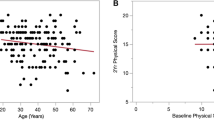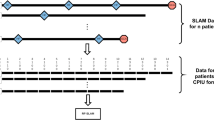Abstract
A variety of adverse outcomes, such as kidney injury, death, cardiac injury, and respiratory failure affect a significant number of patients after surgery. Previous research has investigated possible predictors for these outcomes, including features extracted from physiologic time series, change points in the time series, and prior conditions. This study builds upon this previous work by further exploring time series statistics, such as entropy, long-term memory, and change point analysis, as possibly predictive measures of volatility. These statistics are further examined by conditioning on prior conditions using multilevel modeling. For prediction, we use both random forest models and the robust method of L 1 regularized logistic regression. Predictive results from these models are evaluated using receiver operating characteristic curves and their area under the curve values. While the developed models did not show improvements in predictive accuracy, they did show that change point analysis and measures of entropy and long-term memory can be useful tools in predicting post-surgical adverse outcomes. The multilevel models show the important interactions between prior conditions and time series statistics for predicting adverse outcomes.













Similar content being viewed by others
References
Abelha FJ, Bothelho M, Fernandes V, Barros H (2009) Determinants of postoperative acute kidney injury. Crit Care 13(3):R79
Altmann A, Toloşi L, Sander O, Lengauer T (2010) Permutation importance: a corrected feature importance measure, Bioinformatics 26(10):1340–1347. [Online]. Available: http://bioinformatics.oxfordjournals.org/content/26/10/1340.abstract
Apostolakis EE, Koletsis EN, Baikoussis NG, Siminelakis SN, Papadopoulos GS (2010) Strategies to prevent intraoperative lung injury during cardiopulmonary bypass. J Cardiothorac Surg 5:1
Aranki SF, Shaw DP, Adams DH, Rizzo RJ, Couper GS, VanderVliet M, Collins JJ, Cohn LH, Burstin HR (1996) Predictors of atrial fibrillation after coronary artery surgery. Current trends and impact on hospital resources. Circulation 94(3):390–397
Arozullah AM, Daley J, Henderson WG, Khuri SF (2000) Multifactorial risk index for predicting postoperative respiratory failure in men after major noncardiac surgery. The National Veterans Administration Surgical Quality Improvement Program. Ann Surg 232(2):242–253
Bouwmeester W (2012) Prediction models: systematic reviews and clustered study data. ISBN 978-90-3935-795-8
Brady A, Fowkes F, Greenhalgh R, Powell J, Ruckley C, Thompson S (2000) Risk factors for postoperative death following elective surgical repair of abdominal aortic aneurysm: results from the UK small aneurysm trial. Br J Surg 87:742–749
Breiman L (2001) Random forests. Mach Learn 45:5–32
Candidate AKP, Kalhori SRN (2014) Bayesian autoregressive multilevel modeling of burden of diseas-es, injuries and risk factors in iran 1990–2013. Arch Iran Med 17(1):22
Canver CC, Chanda J (2003) Intraoperative and postoperative risk factors for respiratory failure after coronary bypass. Ann Thorac Surg 75(3):853–857
Chris Fraley S, Washington U, Fritz Leisch SR, Wien TU (2012) Since 2003–12: Martin Maechler; fdGPH, fdSperio, etc by Valderio Reisen, and A. Lemonte., fracdiff: Fractionally differenced ARIMA aka ARFIMA(p, d, q) models, 2012, r package version 1.4-2. [Online]. Available: http://CRAN.R-project.org/package=fracdiff
Duncan C, Jones K, Moon G (1998) Context, composition and heterogeneity: using multilevel models in health research. Soc Sci Med 46(1):97–117
Erdman C, Emerson JW (2008) A fast Bayesian change point analysis for the segmentation of microarray data. Bioinformatics 24(19):2143–2148
Fan R-E, Chang K-W, Hsieh C-J, Wang X-R, Lin C-J (2008) Liblinear: a library for large linear classification. J Mach Learn Res 9, pp 1871–1874. [Online]. Available: http://dl.acm.org/citation.cfm?id=1390681.1442794
Fernandez-Perez ER, Keegan MT, Brown DR, Hubmayr RD, Gajic O (2006) Intraoperative tidal volume as a risk factor for respiratory failure after pneumonectomy. Anesthesiology 105(1):14–18
Fernandez-Perez ER, Sprung J, Afessa B, Warner DO, Vachon CM, Schroeder DR, Brown DR, Hubmayr RD, Gajic O (2009) Intraoperative ventilator settings and acute lung injury after elective surgery: a nested case control study. Thorax 64(2):121–127
Grogan E, Morris J Jr, Norris P, France D, Ozfas A, Stiles R, Harris P, Dawant B, Speroff T (2004) Reduced heart rate volatility, an early predictor of death in trauma patients. Ann Surg 240(3):547–556
Gelman A, Hill J (2006) Missing-data imputation. Cambridge University Press
Healey M, Shackford S, Osler T, Rogers F, E. Burns (2002) Complications in surgical patients. Arch Surg 137(5):611–617
Hergenroeder K, Carroll T, Chen A, Kim P, Iurillo C, Terner Z, Gerber M, Brown D (2014) Automated prediction of adverse post-surgical outcomes. In: IEEE Systems and Information Design Symposium (SIEDS), IEEE. IEEE, Charlottesville, VA USA, pp 227–232
Hill SE, van Wermeskerken GK, Lardenoye JW, Phillips-Bute B, Smith PK, Reves JG, Newman MF (2000) Intraoperative physiologic variables and outcome in cardiac surgery: Part I. In-hospital mortality. Ann Thorac Surg 69(4):1070–1075
Jones K, Duncan C (1995) Individuals and their ecologies: analysing the geography of chronic illness within a multilevel modelling framework. Health Place 1(1):27–40
Kaplan DT, Furman MI, Pincus SM, Ryan SM, Lipsitz LA, Goldberger AL, Goldberger AL (1991) Aging and the complexity of cardiovascular dynamics. Biophys J 59(4):945–949
Kapetanios G, Tzavalis E (2004) Modelling structural breaks (unpublished)
Lee TH, Marcantonio ER, Mangione CM, Thomas EJ, Polanczyk CA, Cook EF, Sugarbaker DJ, Donaldson MC, Poss R, Ho KK, Ludwig LE, Pedan A, Goldman L (1999) Derivation and prospective validation of a simple index for prediction of cardiac risk of major noncardiac surgery. Circulation 100(10):1043–1049
Lee S-I, Lee H, Abbeel P, Ng AY (2006) Efficient l1 regularized logistic regression. In AAAI, pp 401–408
Leite A, Rocha A, Silva M (2013a) Beyond long memory in heart rate variability: an approach based on fractionally integrated autoregressive moving average time series models with conditional heteroscedasticity. Chaos 23(2): Art. ID 023103. doi:10.1063/1.4802035
Leite A, Rocha A, Silva M (2013b) Enhancing scaling exponents in heart rate by means of fractional integration. In Computing in Cardiology Conference (CinC). 2013, pp 433–436
Leung J, Dzankic S (2001) Relative importance of preoperative health status versus intraoperative factors in predicting postoperative adverse outcomes in geriatric surgical patients. J Am Geriatr Soc 49(8):1080–1085
Licker M, de Perrot M, Spiliopoulos A, Robert J, Diaper J, Chevalley C, Tschopp JM (2003) Risk factors for acute lung injury after thoracic surgery for lung cancer. Anesth Anal 97(6):1558–1565
Liu L, Leung J (2000) Predicting adverse postoperative outcomes in patients aged 80 years or older. J Am Geriatr Soc 48(4):405–412
Mangano DT, Browner WS, Hollenberg M, London MJ, Tubau JF, Tateo IM (1990) Association of perioperative myocardial ischemia with cardiac morbidity and mortality in men undergoing noncardiac surgery. The Study of Perioperative Ischemia Research Group. N Engl J Med 323(26):1781–1788
Manilich E, Vogel J, Kiran R, Church J, Seyidova-Khoshknabi D, Remzi F (2013) Key factors associated with postoperative complications in patients undergoing colorectal surgery, Dis Colon Rectum 56(1):64–71
Matteson D, James N (2013) A nonparametric approach for multiple change point analysis of multivariate data. J Am Stat Assoc 109:334–345
Mdala I, Olsen I, Haffajee AD, Socransky SS, De Blasio BF, Thoresen M (2013) Multilevel analysis of bacterial counts from chronic periodontitis after root planing/scaling, surgery, and systemic and local antibiotics: 2-year results. J Oral Microbiol 5. doi:10.3402/jom.v5i0.20939
Moorman J, Carlo W, Kattwinkel J, Schelonka R, Porcelli P, Navarrete C, Bancalari E, Aschner J, Walker M, Perez J, Palmer C, Stukenborg G, Lake D, O’Shea T (2011) Mortality reduction by heart rate characteristic monitoring in very low birth weight neonates: a randomized trial. J Pediatr 159(6):900–906
Moorman J, Lake D, Griffin M (2006) Heart rate characteristic monitoring for neonatal sepsis. IEEE Trans Biomed Eng 53(1):126–132
Moran J, Solomon P (2010) Conventional and advanced time series estimation: application to the australian and new zealand intensive care society (anzics) adult patient database, 1993–2006. J Eval Clin Pract 17(1):45–60
Norris P, Ozdas A, Cao H, Williams A, Harrell F, Jenkins J, Jr JM (2006) Cardiac uncoupling and heart rate variability stratify icu patients by mortality, a study of 2088 trauma patients. Ann Surg 243(6):804–814
Palomba H, de Castro I, Neto A, Lage S, Yu L (2007) Acute kidney injury prediction following elective cardiac surgery: Akics score. Kidney Int 72:624–641
Pickett KE, Pearl M (2001) Multilevel analyses of neighbourhood socioeconomic context and health outcomes: a critical review. J Epidemiol Community Health 55(2):111–122
Pincus SM (1991) Approximate entropy as a measure of system complexity. Proc Natl Acad Sci USA 88(6):2297–2301
Politano A, Riccio L, Lake D, Rusin C, Guin L, Josef C, Clark M, Sawyer R, Moorman J, Calland J (2013) Predicting the need for urgent intubation in a surgical/trauma intensive care unit. Surgery 154(5):1110–1116
Rebecca Killick IE, Haynes K (2014) Changepoint: An R package for changepoint analysis, 2014, r package version 1.1.5. [Online]. Available: http://CRAN.R-project.org/package=changepoint
Richman JS, Moorman JR (2000) Physiological time-series analysis using approximate entropy and sample entropy. Am J Physiol Heart Circ Physiol 278(6):H2039–2049
Ryan ML, Thorson CM, Otero CA, Vu T, Proctor KG (2011) Clinical applications of heart rate variability in the triage and assessment of traumatically injured patients. Anesth Res Pract 2011:416–590
Sanagou M, Wolfe R, Forbes A, Reid CM (2012) Hospital-level associations with 30-day patient mortality after cardiac surgery: a tutorial on the application and interpretation of marginal and multilevel logistic regression. BMC Med Res Methodol 12(1):28
Sessler DI, Sigl JC, Kelley SD, Chamoun NG, Manberg PJ, Saager L, Greenwald S (2012) Hospital stay and mortality are increased in patients having a triple low of blood pressure, low bispectral index, and low minimum alveolar concentration of volatile anesthia. Anesthesiology 116(6):1195–1205
Stekhoven DJ, Buehlmann P (2012) Missforest - non-parametric missing value imputation for mixed-type data. Bioinformatics 28(1):112–118
Terner Z, Carroll T, Brown DE (2014a) Time series forecasts and volatility measures as predictors of post-surgical death and kidney injury. In: Healthcare Innovation Conference (HIC), 2014 IEEE. IEEE, pp 319–322
Terner Z, Carroll T, Brown DE (2014b) Measures of entropy and change point analysis as predictors of post-surgical adverse outcomes. In: 2014 IEEE International Conference on Bioinformatics and Bioengineering (BIBE). IEEE, pp 54–61
Tsuruoka Y, Tsujii J, Ananiadou S (2009) Stochastic gradient descent training for l1-regularized log-linear models with cumulative penalty. In ACL-IJCNLP 2009, pp 477–485. [Online]. Available: http://www.aclweb.org/anthology/P/P09/P09-1054.pdf
Wagner AK, Soumerai SB, Zhang F, Ross-Degnan D (2002) Segmented regression analysis of interrupted time series studies in medication use research. J Clin Pharm Ther 27(4):299–309
Weir M, Aronson S, Avery E, Pollack C Jr (2011) Acute kidney injury following cardiac surgery: role of perioperative blood pressure control. Am J Nephrol 33:438–452
Wuertz D, Michal Miklovic YC, Boudt C, Chausse P et al (2009) fGarch: Rmetrics—Autoregressive Conditional Heteroskedastic Modelling, r package version 2110.80. [Online]. Available: http://CRAN.R-project.org/package=fGarch
Yang P, Dumont G, Lim J, Ansermio J (2005) Adaptive change point detection for respiratory variables. In 27th Annual International Conference of the Engineering in Medicine and Biology Society, 2005. IEEE-EMBS 2005, pp 780–783
Zeileis A, Leisch F, Hornik K, Kleiber C (2002) Strucchange: an R package for testing for structural change in linear regression models. J Stat Softw 7(2):1–38
Zeileis A, Kleiber C, Kraemer W, Hornik K (2003) Testing and dating of structural changes in practice. Comput Stat Data Anal 44:109–123
Acknowledgments
We acknowledge the anesthesiology expertise provided by Dr. Marcel Durieux and Dr. Douglas Colquhoun and the technical assistance provided by Dr. Matthew Gerber. We also acknowledge the detailed and helpful comments provided by the reviewer. This work was partially supported by SAIC under Grant number PO10018981.
Author information
Authors and Affiliations
Corresponding author
Additional information
D. E. Brown: Fellow, IEEE.
Rights and permissions
About this article
Cite this article
Terner, Z., Brown, D.E. Preconditions and multilevel models in studying post-surgical adverse outcomes. Netw Model Anal Health Inform Bioinforma 4, 20 (2015). https://doi.org/10.1007/s13721-015-0091-4
Received:
Revised:
Accepted:
Published:
DOI: https://doi.org/10.1007/s13721-015-0091-4




